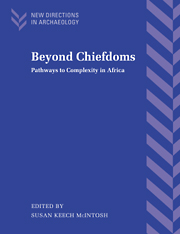Book contents
- Frontmatter
- Contents
- List of figures
- List of tables
- List of contributors
- Preface
- 1 Pathways to complexity: an African perspective
- 2 The segmentary state and the ritual phase in political economy
- 3 Perceiving variability in time and space: the evolutionary mapping of African societies
- 4 Western representations of urbanism and invisible African towns
- 5 Modeling political organization in large-scale settlement clusters: a case study from the Inland Niger Delta
- 6 Sacred centers and urbanization in West Central Africa
- 7 Permutations in patrimonialism and populism: The Aghem chiefdoms of Western Cameroon
- 8 Wonderful society: the Burgess Shale creatures, Mandara polities, and the nature of prehistory
- 9 Material culture and the dialectics of identity in the Kalahari: AD 700–1700
- 10 Seeking and keeping power in Bunyoro-Kitara, Uganda
- 11 The (in)visible roots of Bunyoro-Kitara and Buganda in the Lakes region: AD 800–1300
- 12 The power of symbols and the symbols of power through time: probing the Luba past
- 13 Pathways of political development in equatorial Africa and neo-evolutionary theory
- Index
8 - Wonderful society: the Burgess Shale creatures, Mandara polities, and the nature of prehistory
Published online by Cambridge University Press: 14 October 2009
- Frontmatter
- Contents
- List of figures
- List of tables
- List of contributors
- Preface
- 1 Pathways to complexity: an African perspective
- 2 The segmentary state and the ritual phase in political economy
- 3 Perceiving variability in time and space: the evolutionary mapping of African societies
- 4 Western representations of urbanism and invisible African towns
- 5 Modeling political organization in large-scale settlement clusters: a case study from the Inland Niger Delta
- 6 Sacred centers and urbanization in West Central Africa
- 7 Permutations in patrimonialism and populism: The Aghem chiefdoms of Western Cameroon
- 8 Wonderful society: the Burgess Shale creatures, Mandara polities, and the nature of prehistory
- 9 Material culture and the dialectics of identity in the Kalahari: AD 700–1700
- 10 Seeking and keeping power in Bunyoro-Kitara, Uganda
- 11 The (in)visible roots of Bunyoro-Kitara and Buganda in the Lakes region: AD 800–1300
- 12 The power of symbols and the symbols of power through time: probing the Luba past
- 13 Pathways of political development in equatorial Africa and neo-evolutionary theory
- Index
Summary
The organic analogy
High in the Canadian Rockies of Yoho National Park lie outcrops of early Cambrian shale that contain the fossils of creatures as exotically named – Ayesheaia, Wiwaxia, Anomalocaris, Hallucigenia – as they are themselves fantastic and, indeed, out of this world. They have, as Stephen J.Gould (1989) proclaims in the book from which our title is derived, changed our view of life, for, despite the small numbers of species represented, they are more disparate – more varied at the level of phylum and class – than the “entire spectrum of invertebrate life in today's oceans” (p.25), a spectrum now characterized by profligate diversification of a restricted number of classes.
This disparate, but not diverse, early Cambrian fauna appears to have arisen explosively in what must be the type specimen of punctuated evolution. There is, for the majority of these creatures, no lengthy preceding record of gradual change. Rather, some 600 million years ago, new patterns of life suddenly radiate through the Cambrian oceans. Elsewhere, Gould argues that this steep rise in organic diversity in the first 10 to 20 million years of the Cambrian, “was merely the predictable outcome of a process inexorably set in motion by an earlier Pre-Cambrian event … that initiated the evolution of complex life.” The event, or rather complex of events, was the development of eukaryotic cells and of sexual reproduction. Once these were in place “[t]he pattern of the Cambrian explosion seems to follow a general law of growth” (Gould 1979: 127), the sigmoid curve that classically characterizes the career of a colony of bacteria on a Petri dish (Figure 8.1a).
- Type
- Chapter
- Information
- Beyond ChiefdomsPathways to Complexity in Africa, pp. 97 - 109Publisher: Cambridge University PressPrint publication year: 1999
- 5
- Cited by



